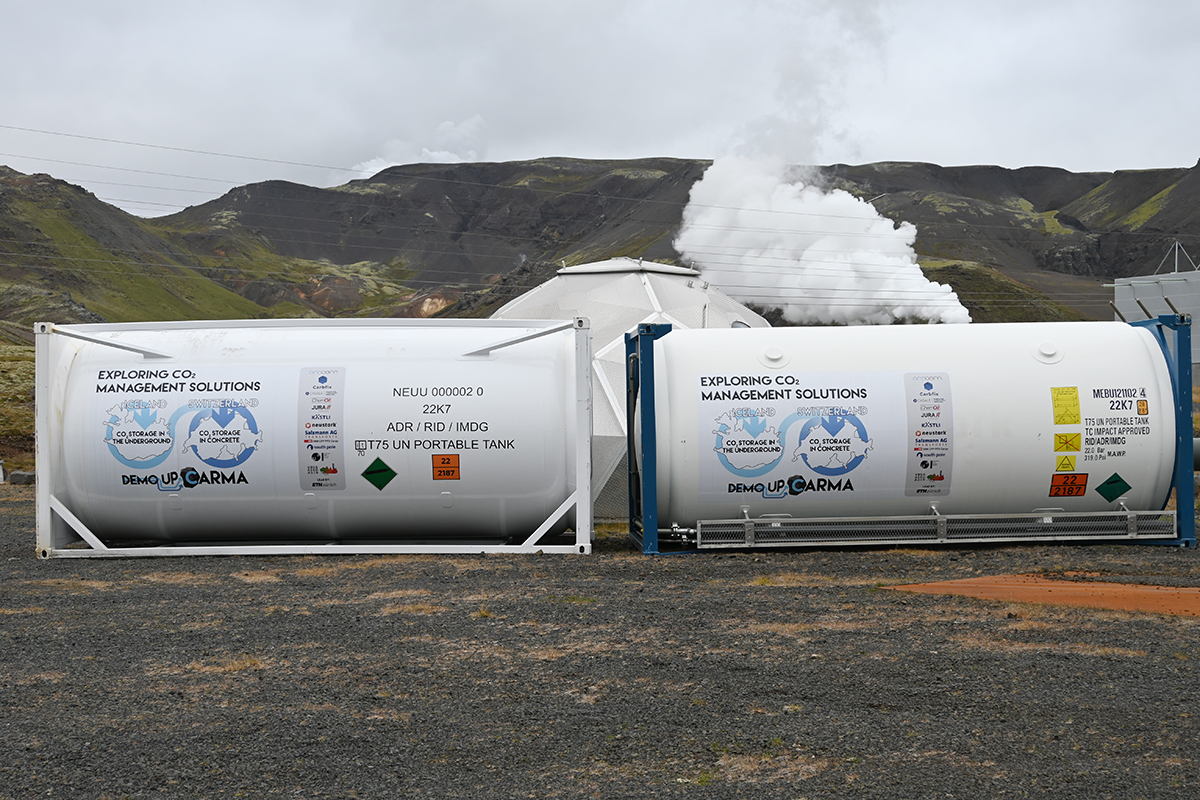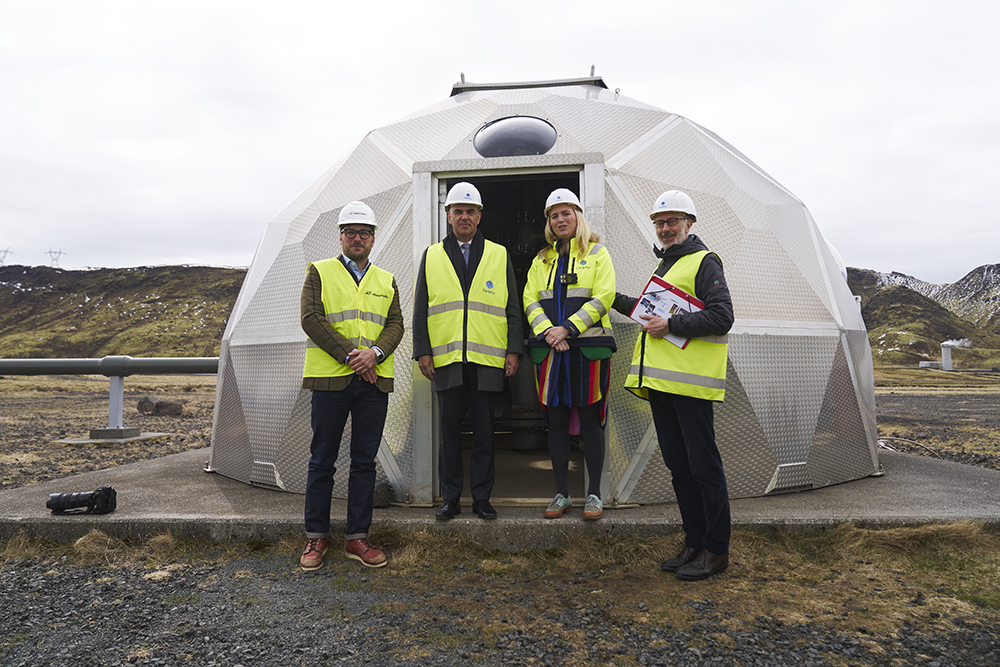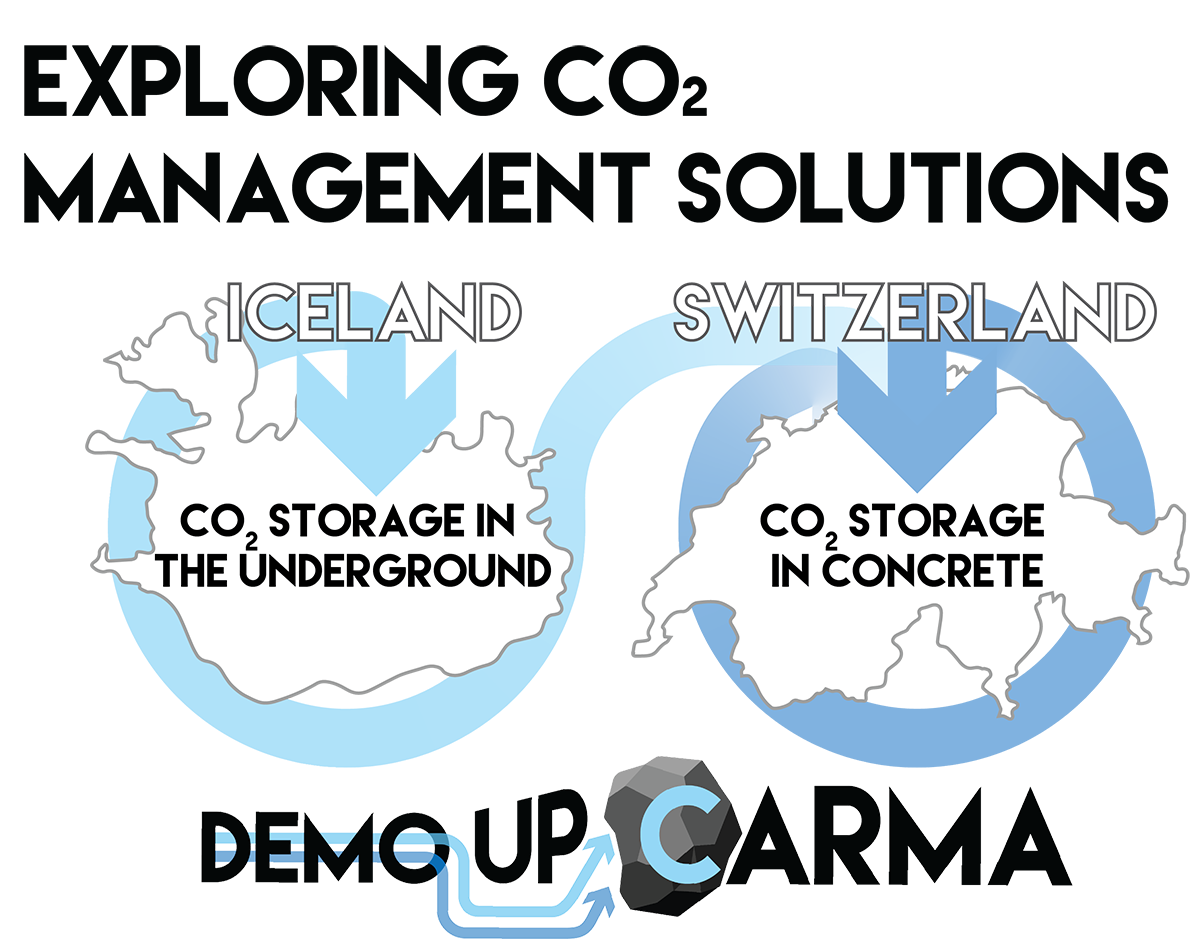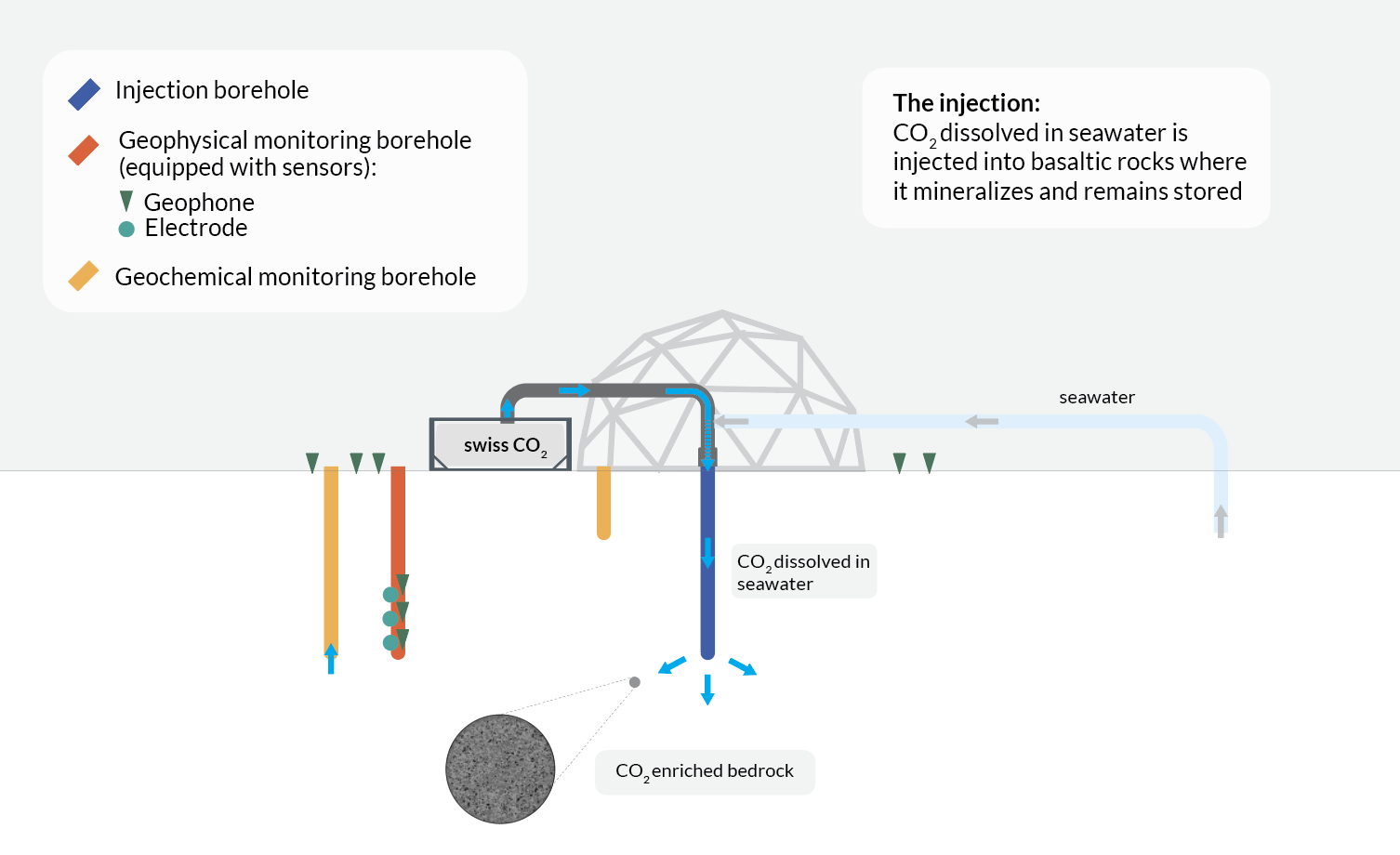News and events
- 2023-06-14
DemoUpStorage measurements started last week in Helguvík (ISL)
Read more...Before the injection of Swiss CO2 in Helguvík (ISL), a team of scientists from the DemoUpStorage consortium* from Switzerland just started with measurements of the underground where the CO2 will be injected. The drilling of the boreholes was recently completed.
Drilling three boreholes down to a depth of 400 m in the Icelandic Basalt layers was more challenging than anticipated one year ago and had already started delayed due to disruptions in the global supply chain. The drilling of the boreholes – an injection borehole, a geophysical monitoring borehole, and a shallow and a deep geochemical monitoring borehole - was completed in early June. As a next step, scientists from the DemoUpStorage team with support from Carbfix just started the measurement campaign that establishes the background conditions before the injection of CO2. One main goal of the pilot project will be to inject for the first time CO2 dissolved in seawater into the Basaltic underground, a novel technology that reduces the need for freshwater and hence reduces the environmental footprint. ETH Zurich will oversee the geophysical monitoring of the CO2 injection, with the aim of establishing for the first time the mineralisation through geophysical methods. The Icelandic partner company Carbfix will oversee the injection of CO2 into the basaltic subsurface and monitor the fate of the injected CO2 using already established geochemical monitoring methods.
Characterization measurements
As part of this campaign a range of geophysical and geochemical measurement between boreholes and from the surface are being conducted. Scientists of the Swiss Seismological Service (SED) at ETH Zurich are leading the geophysical measurements which started with a seismic characterization of the underground between the boreholes. This means that a source sending acoustic signals is lowered into one borehole. In a second borehole, receivers are placed to determine the velocity of the waves travelling through the underground. At the same time, receivers placed at the surface around and between boreholes will measure the waves travelling to the surface. This will allow the scientists to derive a tomographic image of the seismic velocities between the two wells. The expected mineralization of CO2 and associated carbonite deposits will have an impact on seismic velocity, which should be reflected in repeat measurements in a few months.
In addition, scientists are conducting Ground Penetrating Radar (GPR) measurements to further characterize the subsurface. The single-hole GPR consists of a transmitter and receiver antenna that are placed in the same borehole. The transmitter emits a high-frequency electromagnetic wave which bounces back by fluid or gas filled discontinuities. This allows the research team to image structures such as faults and fractures, and, by doing repeated measurements, to track the migration of CO2. The frequency of the electromagnetic wave is in the range of 100 MHz and allows for very high resolution of even very thin (millimetre scale) fractures. This resolution exceeds seismic imaging and supports very fine-grained characterization and ultimately reservoir modeling, but is limited to the immediate vicinity of the borehole.
On a test basis, the researchers are additionally recording seismic signals with a fiber optic cable, which also enables very high-resolution measurements of seismic velocity at intervals of 40 cm along the borehole. For monitoring seismic activity, five broadband seismometers have been installed since September 2022.
Geoelectrical and geochemical measurements
In addition to these characterization measurements, which are repeated at larger time intervals, the research team has installed instruments to measure geoelectric and geochemical parameters on a daily basis.
In order to map the dispersion of the injected CO2 in real time, daily measurements of electrical resistivity will be made in the geophysical observation well at injection depth (350-400 m). The expectation is that the addition of CO2 and, in particular, the onset of mineralization processes will result in a measurable change in electrical resistivity.
An Eawag team is leading the geochemical monitoring, which is based on the miniRUEDI, a portable mass spectrometer. This can be used to measure CO2 and other gases dissolved in water in minute quantities. Over the next few months, this will be used to continuously measure the CO2 content from several boreholes. The researchers will later use helium as a tracer, added in small amounts to the injected CO2 -saltwater mixture to better characterize fluid transport in the basalt layers. Helium is a commonly used tracer for geochemical investigations that is neither hazardous nor polluting and used in minimal amounts. Accompanying this, a team from ETH Zurich is carrying out geobiological measurements. Here, water samples are taken before, during and after injection to observe the development of microorganisms.
This thorough measuring campaign takes about two weeks. Shortly after these measurements, the Carbfix team will start setting up their injection system to inject in the next 6 – 12 months 500 – 1000 tons of CO2 transported from Switzerland to Iceland.
* The team consists of scientists from ETH Zurich, the Swiss Seismological Service (SED) at ETH Zurich, Eawag and Carbfix
More pictures of the ongoing work in Helguvík can be found here.
- 2023-05-17
Why the Swiss are shipping CO2 to Iceland

In a recent interview, project coordinator Marco Mazzotti explains the goals pursued in DemoUpCARMA & Storage and why Federal President Alain Berset is interested in this project.
Click here for the interview.
- 2023-05-16
President Berset visits the DemoUpCARMA project in Hellisheiði (ISL)
 Read more...
Read more...During his visit to Iceland, President of the Swiss Confederation Alain Berset toured the Hellisheiði plant, where the initial four shipments of CO2 (80 tons in total) from Switzerland are currently being injected underground. The plant, operated by Carbfix, a partner of DemoUpCARMA, injects CO2 mixed with water for permanent mineralization at its existing wells by the geothermal power plant in Hellisheiði. Marco Mazzotti, coordinator and head of the DemoUpCARMA project at ETH Zurich, attended the visit as the project representative to offer insights.
The initial CO2 deliveries served as a test for establishing a supply chain from Switzerland to Iceland. This test not only provides empirical data for conducting a comprehensive life cycle assessment but also helps identifying existing issues in setting up such a supply chain.
Under the DemoUpCARMA pilot project, a new process will be tested, involving the injection of CO2 dissolved in sea water into the subsurface for mineralization. The injection is scheduled to start in Autumn 2023, and preparations are currently underway in Helguvík to set up the necessary equipment and measuring instruments. Once the plant is completed, the transport of CO2 from Switzerland to Iceland will resume for injecting CO2 into the subsurface at Helguvík.
Furthermore, president Berset visited the Orca plant operated by the Swiss company Climeworks, which extracts CO2 directly from the air. The CO2 captured by Climeworks is also injected by Carbfix in the Icelandic underground for permanent storage via mineralization.
Image credit: Carbfix / Hörður Sveinsson
- 2023-03-13
Interim reports of the work packages now available

The interim reports of work packages 2 to 5 are now available online. They provide a good overview of initial results, but also of the difficulties and existing open questions identified by the various teams in the work packages.
The interim reports are available online here.



